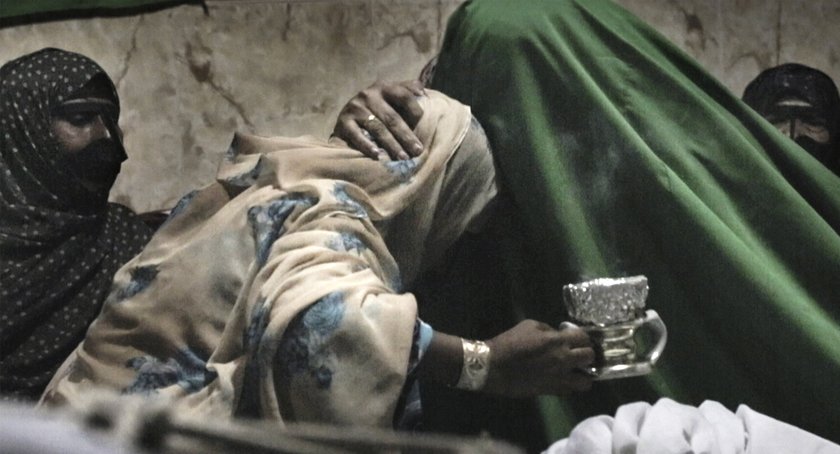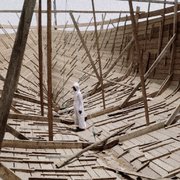Filmmaker/artist Giulio Squillacciotti and anthropologist Camilla Insom took audiences at WOMEX 18 on a mystical journey through an unknown Iranian musical ritual with their film Archipelago. Insom, who lives and works between Rome, Italy and Sulaimaniyah, Iraqi Kurdistan, has been researching the mutation of the sacred in different contexts through the analysis of ritual practices and how they are changing. Squillacciotti lives and works between Italy and the Netherlands. His works are mainly focused on storytelling, cultural apexes and the way traditions re-shape themselves in new contexts. The pair began working on Archipelago in 2015 and premiered the film in 2017 at the Torino Film Festival.
The documentary weaves together stories and landscapes of ancient myths, exorcism rituals, sounds and spirits, exploring the relation between the Bandari community - an Afro-Iranian Sunni minority that lives on a group of Iranian islands in the Persian Gulf - and the Bād spirits. Spirits of different heritages and origins, called Bād, the Persian word for wind, move through the air, taking possession of the islander’s bodies and can only be calmed through a music ceremony called the Zār ritual. Accompanied by chants, moans and drums, locals gather in these ceremonies where [i]mama[/]- or baba- Zār - the community’s spiritual guides - communicates with the spirits, sometimes to ask for advice, and at other times to discipline their behavior.
Reflecting on the centrality of the Persian Gulf as a historical crossing point for both trade and cultures, as well as the Hormozgan province being an important stop on the spice route since around BC2000, these rituals are nothing less than a journey through African rhythms, Persian beliefs and Arab and Indian customs all combined. Through pounding drum rhythms and wailing vocal choruses, the audience is given an unexpected glimpse of a region in Iran where humans and spirits coexist.
WOMEX Film had the chance to talk with Giulio Squillacciotti about his work and research.
22 November 2018, Interview & article by Virginia Pietromarchi
Virginia Pietromarchi Giulio, you are a filmmaker and artist whereas Camilla is an anthropologist based in the Iraqi Kurdistan. What drove the two of you to work together?
Giulio Squillacciotti In my previous documentary (RMHC 1989/1999 Hardcore a Roma), I focused on the punk music scene in Rome. I was interested in how the Roman culture absorbed and reinterpreted a genre coming from the United States. Camilla’s research looks at the mutations of Sufi brotherhood in Iraqi Kurdistan. So as you can see, even though we have different approaches, the core of both of our research is the same: how traditions change and reshape themselves by shifting the original context and moving to another one. In the case of Archipelago what interested us was how a ritual travelling from Africa towards Iran changed and gained new features. We were interested in how different layers of traditions merge together into this ritual in Iran.
VP The Bandari community is mostly concentrated in the Hormozgan province, the southern region of Iran. Its proximity to the Arabian peninsula strongly resonates in the community’s dialect and customs. But during these rituals, if we think about the music for example, there are a lot of African features. Could you tell us more about this connection and how these spirits arrive to Iran?
GS The ritual originates from the horn of Africa, meaning Somalia, Ethiopia and there were sparks of it in Egypt as well, always with different names. In Ethiopia for example, you find the minghis, lumbi and saar, which is the equivalent of the Iranian Zār. From Africa, the ritual spread towards the east and west. While travelling towards the west, these rituals crossed the ocean and arrived straight to the southern America’s coasts where they reshaped themselves through local features but remained quite similar. But when these rituals traveled towards the east, they crossed different countries, cultures and religions that were somehow absorbed and incorporated into the ritual. Islam was a major element that shaped the original ritual. During the rituals we see that the people always praise Allah first, then the prophet Muhammad and then they start singing for the spirit. One also hears the spirits talking in Persian or in Arabic, or even in Urdu - among others - because they still speak their language of origins. This is why the mama or baba- Zār has to undertake a long training to become a spiritual guide given that he/she has to able to communicate with all Bāds.
VP During the ceremonies we can see both young and old people sharing this moment together, did you get the feeling that the younger generation would continue to keep this tradition alive? Do they still believe in it?
GS Young people are on their phones during the ceremonies, sometimes they even laugh at the person who is possessed by the spirit. An old man told me that the younger generation are no longer scared of the Bād, which is a problem because the day they will be possessed by them they will be even more scared. But the young still believe in them. If they are not feeling well, they go to the doctor, but if the doctor can’t find anything wrong with them, they will go to the mama or baba-Zār to get a second opinion.
VP Drums and chants are a fundamental aspect of these rituals. The resulting music is quite different from what is usually identified as traditional Persian music. What attracted you the most about this music?
GS There is something very peculiar about the music we hear during the rituals. No string instruments are used; only beats so yes something very different from the traditional music you would hear in Tehran for example. The rhythm, the drums and the chorus are a style that one would expect to find in African countries like Sudan or in Oman, rather than in Iran.
VP Have you thought about recording these sounds?
GS My main focus is music, so yes I’m really interested. I recorded the sounds from the rituals the best I could since during some of them, the music is performed by non professionals and in other cases musicians don’t miss a beat and you can tell they are really well trained, sometimes they also have a conductor. So I would be very interested one day in producing a record of their music which also means going back there and doing it properly.
VP Have you presented Archipelago in Iran yet?
GS The chance to show the film to Iranians would be a true closing of the circle. It would be pretty fundamental for the film. So far we tried, even with some traditional festivals but we couldn’t get through. I would like to screen the film in Tehran in any possible way, even more in the Persian Gulf’s island.
VP The documentary portrays various intimate scenes, from women sharing personal stories about their own spirits, to moments of spiritual possession. How did you gain the local community’s trust to film such intimate moments?
GS We stayed there for a while, mostly to get some notions before starting to film. We were not demanding anything specific from the local community. I guess by being physically there, we gained people’s trust. Then we started to ask about their stories or to simply drive us to where they had their first encounter with the spirit. Going step by step, we got access to the first ritual and after a month they were even calling us proposing to join ceremonies with our camera. That’s how it all started. As filmmakers, we metaphorically disappear from the picture, where Iran’s islands serve as a background to a story told through the daily lives and rituals of the islanders.
VP What was your personal approach to this spiritual dimension, do you believe in the existence of these spirits?
GS Something Camilla and I agreed upon before starting the project was that we would never ask ourselves if the whole thing was true or not. That we would never get too involved. We decided that, staged or not, the fact that these rituals are still taking place, is a story worthy enough to be told.
VP Did you get back with a Jiin in your pocket?
GS Sometimes, in my dreams they still bother me…
Using the virtualWOMEX platform, WOMEX 18 delegates can now watch Archipelago and other films from the 2018 film programme, online through a new venture WOMEX Films on Demand, running till the end of November. We hope that this venture will allow for festival programmers, artists, labels, venue managers who attended WOMEX 18 to continue to use virtualWOMEX to keep conversations going and also be inspired by the film selection to develop new ideas, projects and opportunities.
article posted by:Elisabeth Rohleder, Piranha Arts





